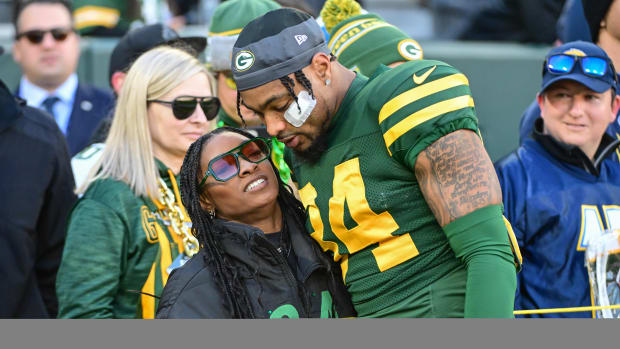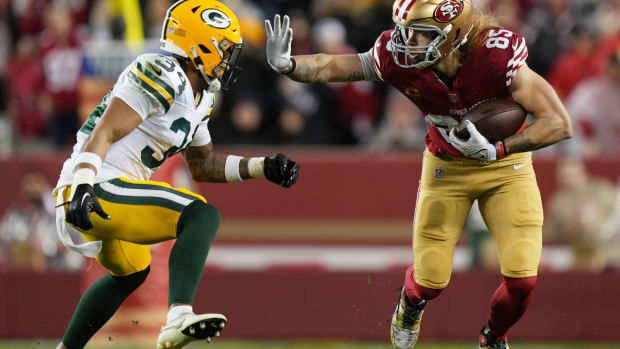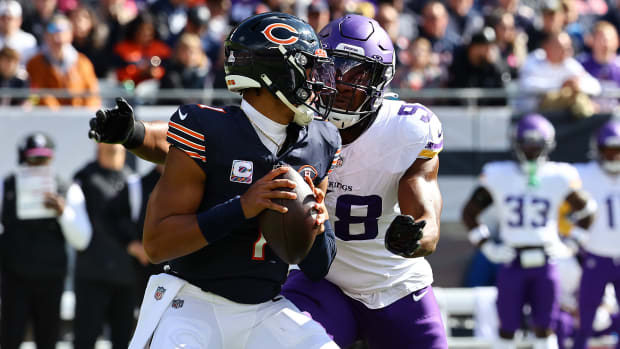Great Unknowns About This Bears Draft
Every NFL Draft creates its own set of questions for a team, much like every game in a season causes questions and free agency causes questions.
It's the old cause-and-effect routine, and just as the draft itself causes great questions about the team it also leads to some about the players selected by general manager Ryan Pace.
In this case, five particular questions beg for an answer beyond whether the Bears can win the division.
5. Is Thomas Graham Jr. an outside cornerback or slot corner?
"Just versatile corner, he can play outside, he can play inside," Pace said.
There are openings in both places and where he tries to line up depends partly on whether veteran free agent acquisition Desmond Trufant can hold up in the spot Kyle Fuller used to play. Graham isn't the only sixth-round pick vying for the slot cornerback spot if he's used there. Duke Shelley is the other one. Fifth-rounder Kindle Vildor might be competition at either spot for him.
The striking difference about Graham is he was rated so highly by many talent evaluators that there is a tendency to think of him as having greater upside than Vildor and Shelley. Besides, everyone has seen Vildor and Shelley play and neither was particularly impressive last year replacing injured Buster Skrine or Jaylon Johnson. And while Pace says Graham can be a slot or on the outside, his exposure to the slot at Oregon was very small.
"We really liked his competitiveness, his energy, kind of the spark that he has," Pace said.
Those are qualities especially critical at all cornerback spots but especially the slot, where receivers can go either direction and the defender sometimes must cover tight ends or backs.
4. Is Khalil Herbert a passing game fit?
Mixed predraft reviews on Herbert's ability to pass block lead to questions because it's a critical role if he's called on to replace David Montgomery. Also, he hasn't caught many passes so no one can be exactly sure how he is as a receiver. He caught only 14 of 24 throws his way while at Kansas, which doesn't suggest excellent hands. However, he caught 8 of 10 at Virginia Tech last season. Being thrown to 10 times isn't exactly enough to go on even if he did look better catching it.
When a player is designated a sub right away as most late-round picks are, they need to be as versatile as possible and play special teams. He can return kicks and cover but can he fit into the passing game?
3. Is Dazz Newsome fast enough for slot receiver?
The slot receiver role traditionally doesn't require great speed. Julian Edelman, Cole Beasley and even Golden Tate haven't been the fastest receivers on their teams but found ways to get open and Newsome has been described this way. Considering he ran 4.59 in the 40 at a pro day, he'll need to have the ability to get open. The problem is in this offense the way coach Matt Nagy wants to run it — the Kansas City model — a slot with tremendous speed can be incredibly destructive and that's what he would like to see from the position. The Bears brought in Damiere Byrd, who isn't necessarily a slot receiver per se. He's been at the Z spot, as well. However, he has lined up in the slot frequently in his career and has the speed needed to play it the way Nagy would like. Can Newsome do enough with own speed to get on the field quickly at this position?
2. Can either tackle pass block well enough for NFL standards?
Pace and Nagy gushed about the run blocking benefits derived from drafting Teven Jenkins and Larry Borom, and both definitely have been rated among the better run blockers among tackles eligible for the draft.
"We feel that his best fit is at either tackle spot for us and really just describing the player for you (media), a powerful tackle, you know he can bend, he can play with leverage, he consistently moves guys out in the run game, which is awesome to see," Pace said while describing Jenkins. "Beyond that, he's got the athletic ability to get to the second level and block in space."
Although the pass blocking ability of Jenkins was also described by Pace, it was the run blocking he emphasized. And Borom was described as a guard or tackle. When players are a fit at either spot, there are naturally questions about whether they have the foot quickness to handle the edge rush.
The NFL is about passing these days and tackles who can't pass block are then guards. The Bears have to hope these are tackles they drafted because they've cut two tackles who probably weren't at their best as physical run blockers but did have the footwork to pass block sufficiently.
1. How long before Justin Fields knows Matt Nagy's offense?
Yes, there is a question about Fields beyond: What size gold suit jacket he wears for enshrinement ceremonies? He's being so universally heralded as the Bears savior that no one is questioning his skills.
The one question everyone asks is: How long before Fields starts? However, the real question is: How long before he gets the offense down well enough to play?
This is because when he starts is largely out of his hands.
It's up to Andy Dalton and whether he can win games. If Fields is able to quickly understand a Nagy offense sometimes described as overly complicated, then he will be ready if Dalton fails to win enough.
If Fields doesn't learn it fast enough, the entire organization is going to look foolish, starting with Pace and Nagy, and including Ted Phillips and George McCaskey because they were the ones who said they believed in their football guys' collaboration enough to think they could supply an answer at quarterback.
Twitter: BearDigest@BearsOnMaven




